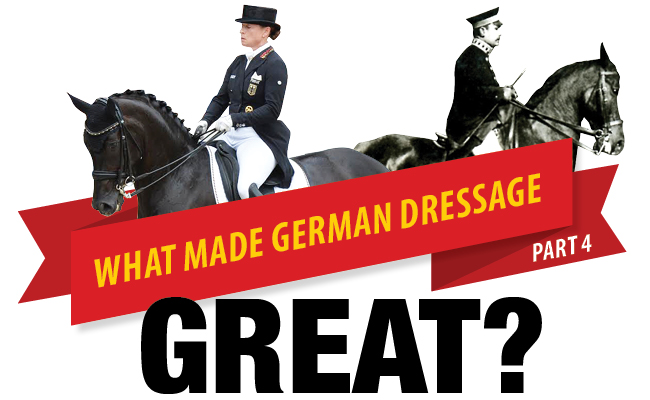
Christopher Hector continues his survey of the influences on dressage greatness
(first you might like to read part one, part two or part three)
Let’s take a breather, and step back in time, to meet two of the more important twentieth century breeders….
Key Players: The breeder – Count Clemens von Nagel
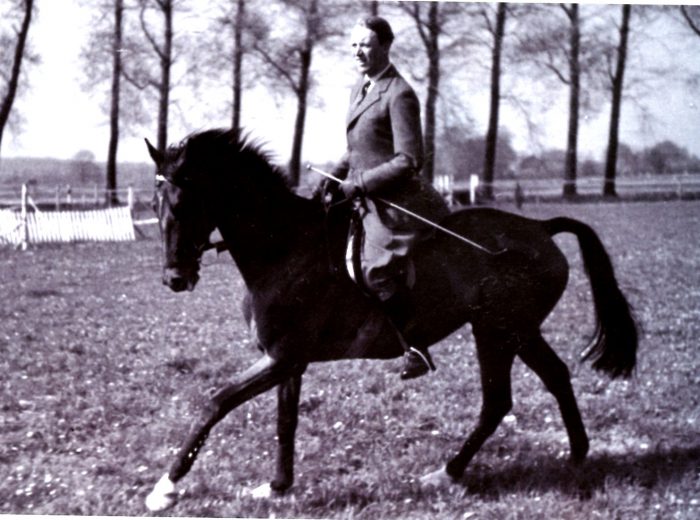
Count Clemens von Nagel established a record at the 1952 Olympic Games that has never been challenged – he bred all three horses in the dressage team on his historic stud, Vornholz, near Warendorf. And yet, when we look closer, we will find that at that time the distinction between jumping and dressage lines had not really emerged and von Nagel was really trying to breed jumpers…
One of the first really influential stallions to stand at Vornholz was the Anglo Arab, Ramzes, who was responsible for one of the three big dressage lines of the 80’s and 90’s, the ‘R’ line of Rubinstein.
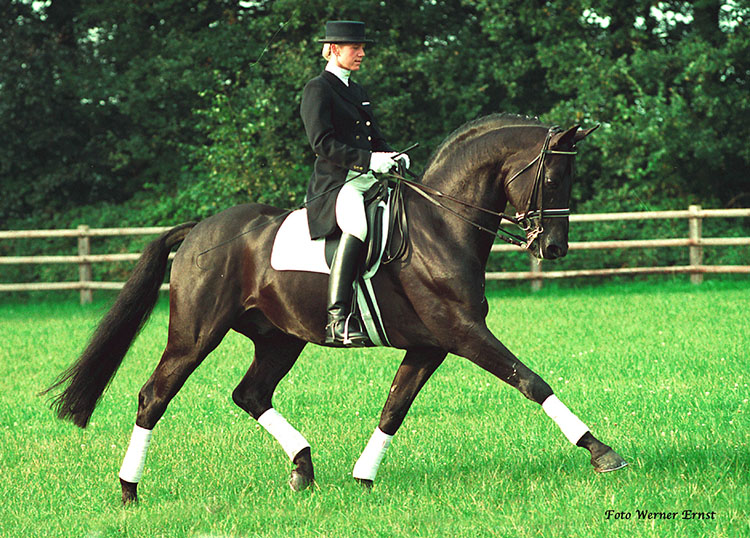
Rubinstein, another of the influential early dressage sires. Here he is with Martina Hanöver who rode him from young horse classes to Grand Prix…
Ramzes was foaled in 1937 in Poland. He was by the Belgian bred Thoroughbred – and successful racehorse – Rittersporn, who was a grand-son of the great French Thoroughbred jumping sire, Le Sancy. This blood also runs in the veins of Wotan who jumped internationally with Hermann von Nagel in the 1930s and was a member of the German team that won the Rome Nations Cup three times in succession. The Rittersporn daughter, Warzawianka represented Poland at the 1936 Olympics.
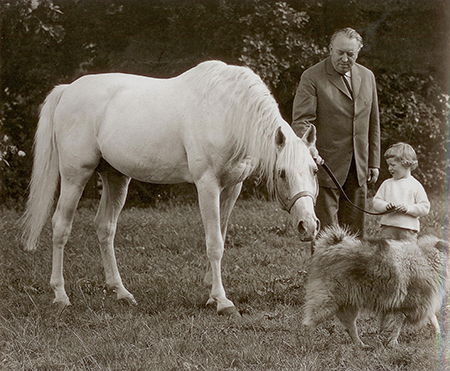
Count von Nagel and Ramzes
Ramzes was out of a mare by Shagya X-3. The Shagya is a breed that has been developed over several hundred years from a base of Andalusian, Lipizzan and Polish Warmblood mares, bred to Arab stallions.
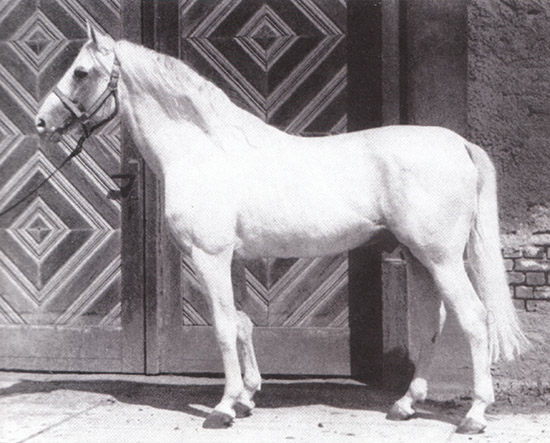
Ramzes, a popular riding and carriage horse
During the Second World War, Ramzes was stabled at the Polish Stud, Janow Podlaski, where he was a popular riding and carriage horse. With the Russian forces advancing, the Polish studs that were under German occupation were relocated to Germany, and Ramzes was one of the horses that crossed the border. After 1945, the horses were returned to Poland, apart from a few which the Polish officers rode in the first riding competitions between the Allied forces. These were held from 1946 onward, and Ramzes was the star with Lieutenant M. Bielecki in the saddle. The rider bought him from the Polish government, and after the communist takeover, Bielecki migrated to the United States and offered to sell the grey stallion to Clemens Freiherr von Nagel, who bred sport horses at his property in Vornholz in Westphalia. He knew Ramzes from his time as Director of the Polish Racot Stud during the war.
more follows
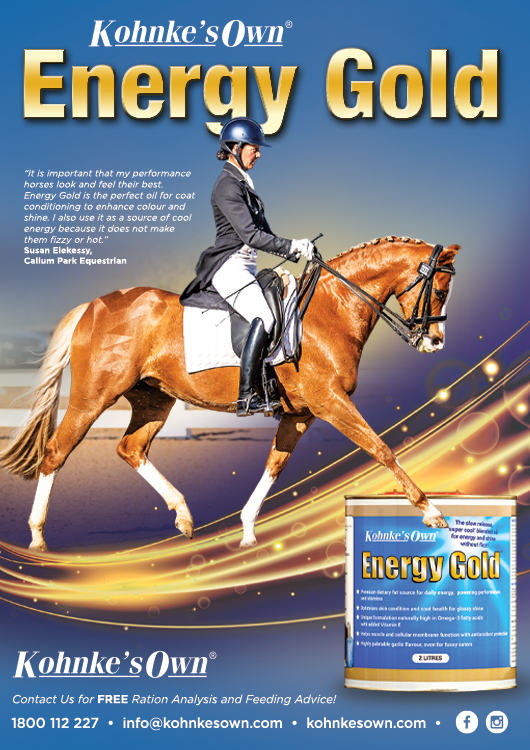
Count von Nagel who gave the stallion to German jumping rider, Hans-Heinrich Brinkmann and he competed successfully in elementary and medium jumping classes. However Ramzes broke his front pastern while being exercised. In those days, dealing with broken legs was even more difficult than it is today, and the stallion was hung in the air by a belt attached to the ceiling for weeks. His good temperament saved him for the career as a breeding stallion.
Ramzes was classified by the Westpahlia Breeding Board under breeding value class IV, but he attracted the attention of the Holstein breeding authorities because of his good jumping genes.
He stood at the Holstein in 1951 and 1952 to refine the heavy Warmblood horses of the area. The first foals that were born in Holstein in 1952 were disappointing, they were lightly built, not very big and difficult to sell – many ended in the slaughter-house. It was also difficult for his sons to be licensed, their cannon bone circumference of around 20 cm was considered very fine in an era where 24 cm was a more common measurement for stallions.
But his jumping offspring from that first period in Holstein turned the tables. They were stars: Retina, ridden by Fritz Thiedemann, Romanus with Hans Günther Winkler, Ramzes XIII with Kurt Jarasinkski and Ramona with Alwin Schockemöhle, established Ramzes’ fame in Holstein, and resulted in him standing there for two more seasons, in 1959 and 1960.
Four licensed stallions were bred in the second stud period in Holstein: Roman, Rigoletto, Raimond and Rhenus. Rigoletto was sold to The Netherlands, while Rhenus ended his days in the circus tent. Roman became a good competition horse, and an excellent sire of broodmares. Raimond was a more attractive type than Roman and sired over 120 daughters and eight stallions, but of these, only Ramiro was a success.
While in Holstein, Ramzes bred showjumpers, in Westfalia, he produced dressage horses. The Ramzes son, Remus won individual dressage silver and team gold at the Tokyo Olympics, where he was ridden by Harry Boldt. Two years later, another son, Mariano, ridden by Josef Neckermann, won the World Dressage Championship, with Remus collecting another silver medal. Mariano won silver at the 1968 Games – and four years later, at the Munich Games, another son, Robin was a member of the German gold medal winning showjumping team.
The Ramzes son, Radetzky established in Westfalia a line that led to Romadour II and in turn to his gold medal-winning son, Rembrandt.
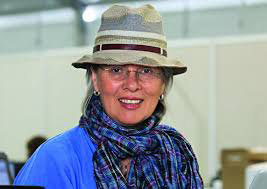
Silke Rottermann interviewed German journalist Gabriele Pochhammer, retired chief editor of St. Georg magazine and now its publisher, on the stud’s history and its influence on today’s breeding. The interview appeared on eurodressage in December 2015.
Gabriele lived at Vornholz when she was in her 20s working for von Nagel. She explained that at first he started with Thoroughbred mares in 1937 but later added Hanoverian mares.
According to Gabriele, the breeding aim was far from the dressage arena: “Initially the aim was to breed horses high in blood for steeple-chasing, which was practiced by the cavalry officers with great passion.”
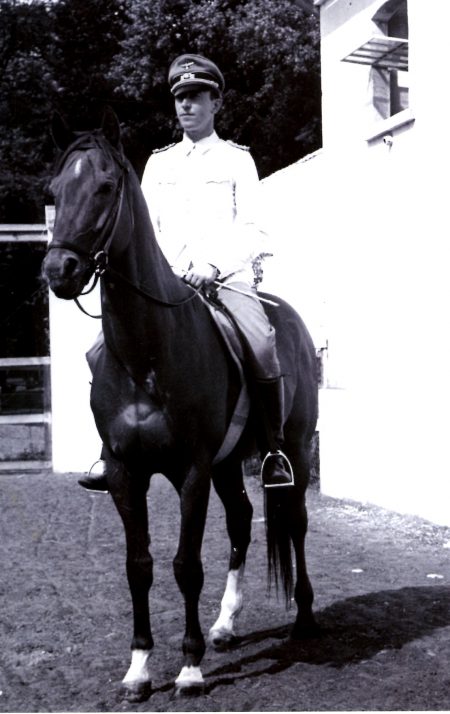
Von Nagel – Cavalry Officer
“At the beginning it was Thoroughbred mares like Perlenreihe (by Anakreon xx) which was paired with the Thoroughbred Marcellus xx who was stationed at Vornholz and brought the successful steeplechaser Perpetua xx (80,000 Deutsch marks in career earnings) and later the dressage horse Pernod xx. The latter won 40,000 DM on the racetrack before he became an international dressage horse and breeding stallion. After the closure of the army racing-stables also the Thoroughbred breeding at Vornholz closed.”
Before the Second World War, the Count also tried to keep alive the Beberbecker horses. He had spent his childhood on the Beberbeck State Stud where his father Paul von Nagel was the Stable Master. The horses bred there were a mix of English Thoroughbred, Norman, Mecklenburger, Hannoverian and Senner (The Senner is a critically endangered German breed of riding horse. It is believed to be the oldest saddle horse breed in Germany, and is documented at least as far back as 1160. It is named for the Senne a natural region of dunes and moorland in Western Germany. A Warmblood, influenced by Arab, Anglo-Arab, Thoroughbred and Iberian stock). The aim at Beberbecker was to breed a fine cavalry horse. The stud was sold to Poland in 1929.
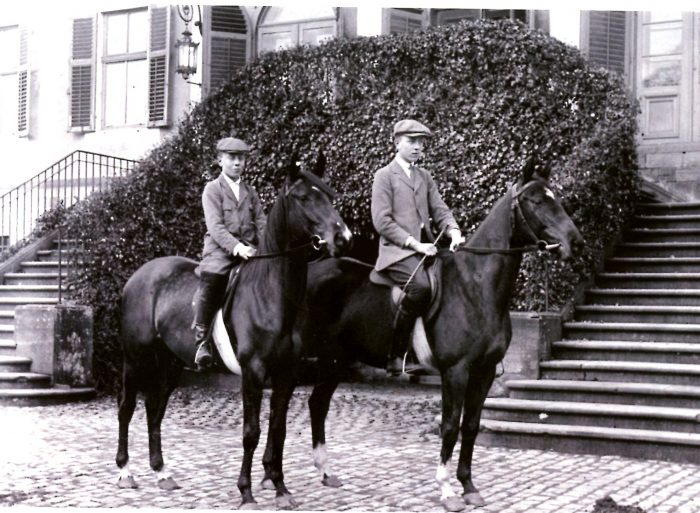
Clemens von Nagel (right) at the Berberbeck Stud
Gabriele takes up the tale: “There were no brood mares from dam lines in Germany anymore, but a few stallions like Thronerbe and Meleager which were used in the Hanoverian breeding area remained. Trendelburg (by Thronerbe) and Finnländerin (by Flirt), in foal by Meleager, carried the Beberbecker blood to Vornholz. Count von Nagel considered the purchase of the Beberbecker stallion Oxyd (by Irrlehrer out of Oxalis, by Metellus xx) as a stroke of luck.”
“So the horse type at Vornholz at those times was a mixture of Hanoverian mares with Beberbecker blood and English Thoroughbred. The aim of breeding was a ‘big framed performance horse similar to an English hunter’.”
After the War, the breeding goal changed radically:
“Vornholz was the first stud which was strictly dedicated to the breeding of a performance horse which made it a pioneer. Different from federal breeding, their horses were not suitable for agricultural work. Especially after the war those responsible for German breeding tried to breed against the mechanization of farming in the so-called ‘elephant-period’. Therefore they bred heavy horses. In the end this was only a delay for the breeding of a modern riding horse. Due to his skill and financial independence Count von Nagel was able to follow his breeding goal at a time in which the small rural breeder was still dependent on the breeding administration and the stable masters.”
Silke asked Gabriele if Vornholz was the first dressage specialist stud in Germany…
“Yes and no. Count von Nagel did not consider himself a dressage horse breeder. The successes of the Vornholz dressage horses at the 1952 Olympic Games in Helsinki (Afrika, Adular, Chronist xx) would not have been possible without Otto Lörke who trained these horses and their riders. Lörke, who had come to Vornholz after the war as a refugee, found excellent horses, but was also able to show them off in the very best way.”
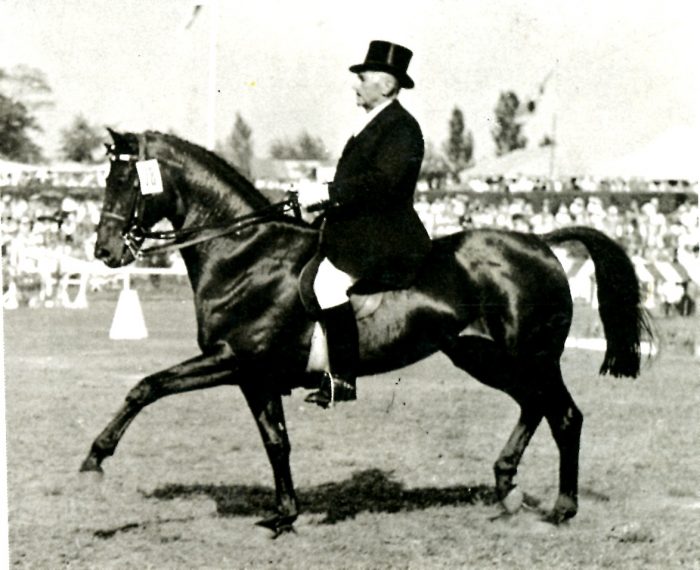
Bred at Vornholz – Chronist xx and Otto Lörke
“Other good dressage horses from Vornholz were sired by Ramzes x (Mariano, Tiga), but also Pernod xx had proven himself as a good dressage sire by producing very beautiful and exceptionally well moving offspring (Macbeth). But Count von Nagel’s heart beat, I think, more for breeding jumping horses, which explains his orientations towards Holstein. Therefore I wouldn’t claim that Vornholz specialized in breeding dressage horses.”
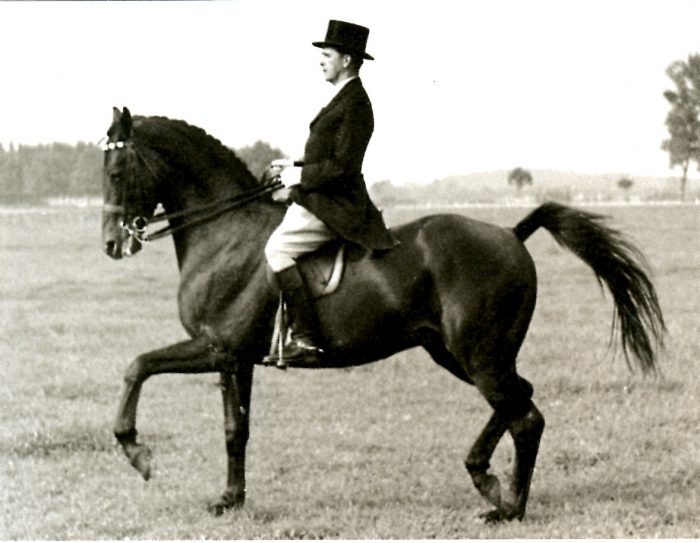
Pernod – racehorse, dressage horse, sire – with Willi Schultheis
Remember that final element in the equation – luck.
One of the first famous jumping sires, Ramiro arrived at Vornholz in utero, and first stood at the Vornholz stud – 1969 to 1977 – where his grandsire, Ramzes stood. In that period he sired the World Cup finalist, Danau (Fatinitza) and the licensed stallion, Romanow.
Ramiro was among the early stallions to compete. During his own sporting career, Ramiro had numerous wins at all levels of showjumping – Nations Cups, Puissance (jumping over 2.2 metres) and in international Grand Prix competition.
In 1974, after his competition career ended, Ramiro was first sold to Fritz Legges’ sponsor, Rudolf Hirschmann but he was then acquired by Zangersheide Stud where he became part of Leon Melchior’s two pronged breeding program: Almé and Ramiro.
The Count acquired another great stallion in 1977, Caletto I, but he died of heart failure that year and it was agreed the stud would be closed down gradually.
This final tribute comes from The Holsteiner Horse, the authors are Dr Thomas Nissen, Donata von Prueßen, Joachim Tietz and Gabriele Pochhammer, and one suspects that these words are Gabriele’s:
“In 1977/78 the breeding establishment was closed down, the fields on which World Champions and Olympic medallists were once reared made way for the sterile greens of a gold course. The indoor school where Otto Lörke trained the Olympic dressage team in 1952, was replaced by a posh clubhouse. However the blood of the Vornholz horses still lives on in the pedigrees of many top stud stallions. One may not be able to compare the horses bred in Vornholz with a long established farmer’s line that had been paired consistently for generations within a population, here the blood of lots of different breeds was united: Hanoverians, Thoroughbreds, Beberbecker, Holsteiner, Anglo-Arab and Anglo-Norman horses. But somehow or other they all fitted together, because there was a clear concept behind them: to breed top performance horses, not show winners. As such Clemens von Nagel was ultimately one of the pioneers of the modern top performance breed, which has developed over the last 40 years and is flourishing today (2009).”
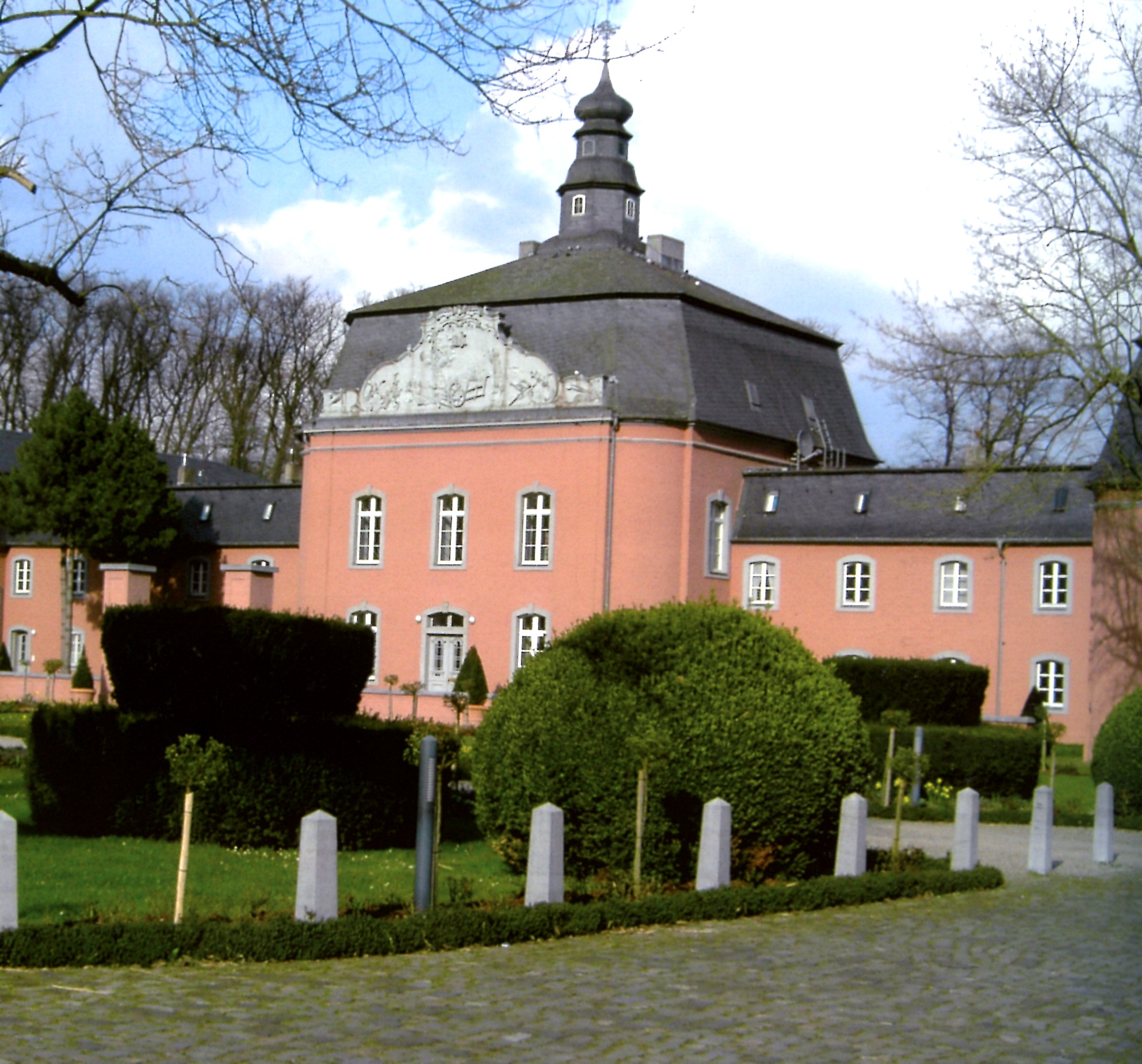
Count von Nagel was also ahead of his time in that he cheerfully refused to follow the dictates of any one of the breed associations, mixing and matching where he saw a need or potential. Nowadays, more and more German breeders are following his example.
next we talk to Dr Roland Ramsauer
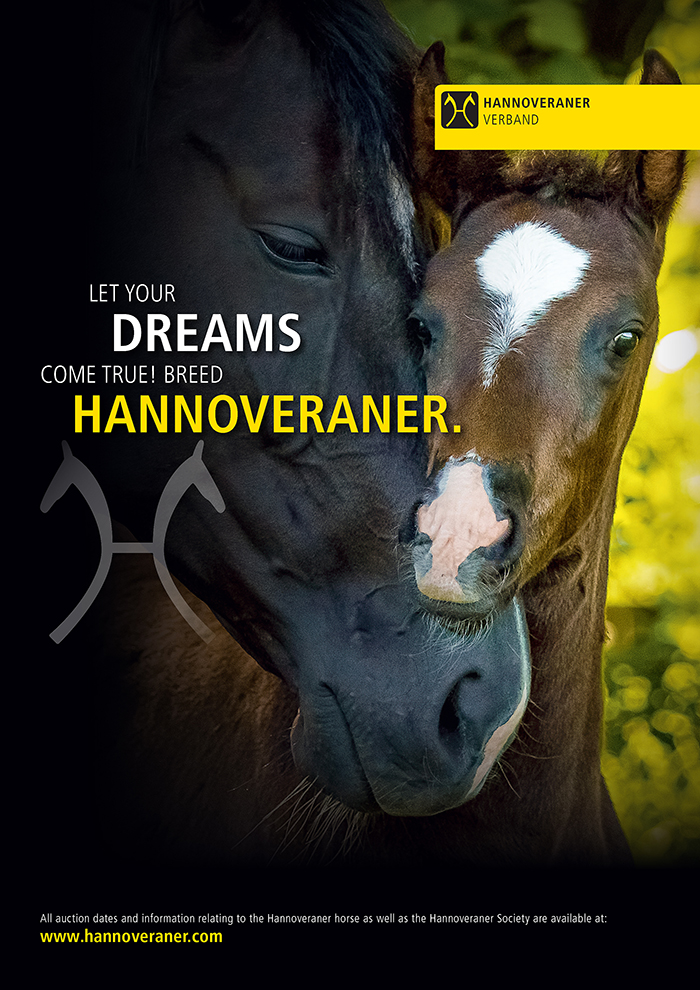
The long time breeding director of the Oldenburg Verband, Dr Roland Ramsauer is now the chief breeding advisor to Europe’s third largest stallion station, Sprehe, a stud that has made its way cheerfully ignoring the brands and looking to the blood, and more importantly, performance:
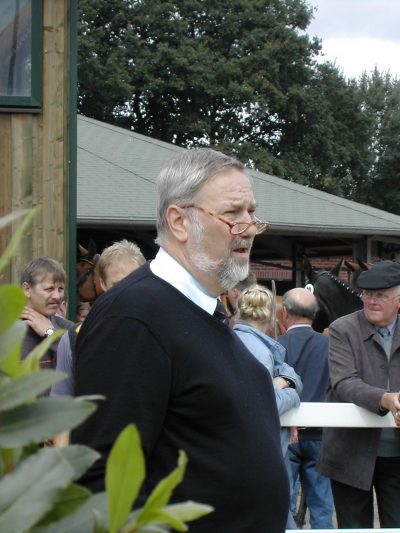
Roland Ramsauer – times have changed
“Of course, when I started thirty years ago, the breeder would ask, Oh what breed is Hickstead White? Or what breed is Fürst Wilhelm? Today nobody asks. They all ask what is the stallion doing, they only look to the pedigree and they don’t care if he has a Bavarian brand or an Oldenburg brand, or Netherlands or Holsteiner brand.”
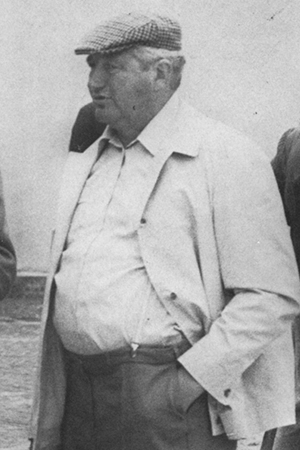
One of the great breeders: Georg Vorwerk
Roland Ramsauer worked closely with the breeder who had more to do with shaping the modern dressage horse than any other, Georg Vorwerk who was born 1923 and died 1988, having transformed the face of Warmblood breeding.
It is interesting that the two neighbouring breeding districts, Hanover and Oldenburg have such different approaches to the structure of their associations. Hanover’s model, which has been the model for most German breeding associations, revolved around a state stud, Celle, sending state owned stallions out into the little breeding stations dotted all over the countryside. This made the stud master in Celle a very powerful man, a major influence in the selection of stallions and then in deciding which stallion should go to which breeding district. The Oldenburgers took a more freewheeling approach, no state stud, but a series of private stallion stations, were the back-bone of their breeding program – and the greatest of them all was Gestüt Vorwerk.
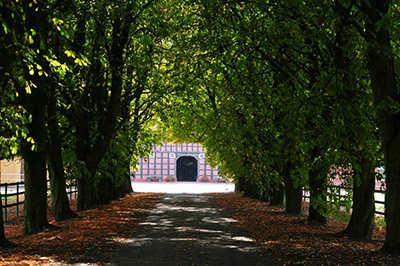
The Vorwerk farm in Capplen was already in existence in 1310. In 1875, Georg Vorwerk started with the stallions, Agrarian and Macro. In 1928, his son, Georg (‘Gregor’) took over and stood the Lupus xx son, Ludenburg, one of the early Thoroughbred influences in the Oldenburg breed.
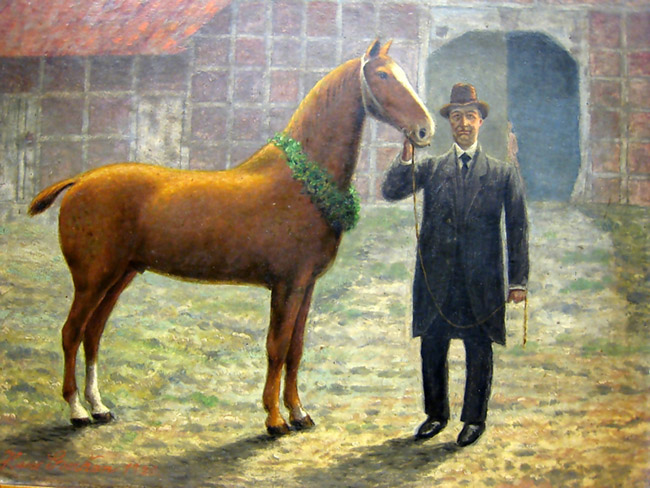
The first Georg Vorwerk
Gregor’s son, Georg inherited the farm and travelled to France in 1968, returning with the most influential breeding stallion in modern German Warmblood history, Furioso II.
.Dirk Zagers in issue 34 of Breeding News, published in 1999, tells the story and like many of the stories about the great breeder, it involves a good deal of drinking:
“Furioso II was born in 1965 at the stud farm of Henri Lemoine in the Calvados area of Normandy, this son of the great Furioso xx and Dame de Renville was sold to Alfred Lefèvre at the age of three.”
“Only eight days later, a group of Oldenburger breeders visited the stables of Mr Lefèvre in order to find a blood-type stallion that could help them to change the heavier Oldenburger mares into modern sport horses. Georg Vorwerk, regarded as a stallion owner with a vision and a eye for a good horse could not find what he really wanted as Alfred showed him the stallions he wanted to sell.”
“It took until after dinner when Georg spotted a dark chestnut with a white face and asked about the breeding of this youngster. As he heard that this was a son of the famous Furioso xx and that he was not for sale, negotiations started at the table that were later described as remarkable, and it wasn’t until late that night that an agreement was made between the two great horsemen and the legendary Furioso II was born.”
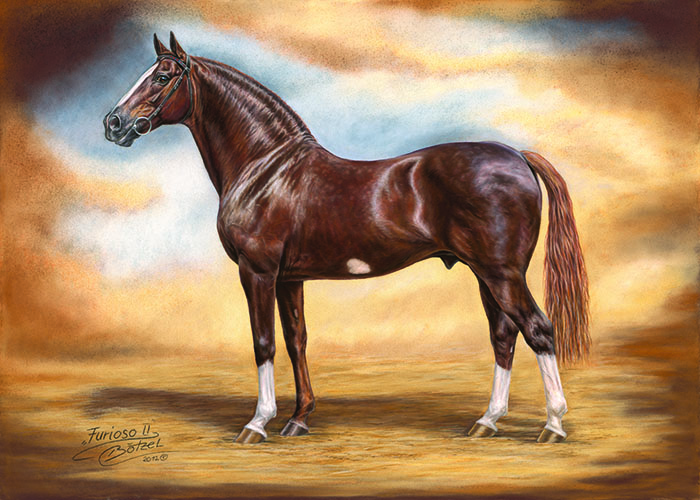
Furioso II – is he the most important stallion in German breeding?
Furioso II was recently described by Ludwig Christmann of the Hanoverian Verband, as the most influential stallion of them all, and it is easy to agree with him. The Selle Français chestnut has been equally influential in jumping and dressage. Roland Ramsauer takes up the story in an interview I conducted in 2017:
“Of course I know Furioso II, because when I started he was five or six-years-old and he was very successful. At that time, he was covering 450 mares per season, natural covering! I was a university student at the time, and the professor told me, with natural serving a stallion can cover a maximum of 200 mares. I said, Mr Professor, I am sorry but I know a stallion that covers over 450 mares. He said, I don’t believe that. Then I will invite you to come to the station of Mr Vorwerk and there you can see that Furioso covers for the first time in the morning, at five o’clock, at eight o’clock, for the second time, twelve o’clock, the third time. Three o’clock in the afternoon for the fourth time and seven o’clock in the evening for the fifth time, in the main season, May, June, July. The professor saw it for himself, unbelievable, then Mr Vorwerk said, let’s go to the dining room and have a Schnapps. The whole day, and up till the next morning, they were drinking and talking about Furioso and how he was found in France.”
“There is another story. When I had been the breeding director for six months, I met Dr Lehmann, the Director from Westphalia, and a very intelligent, well-educated man. He said to me, Herr Ramsauer, you are a nice man, and I will tell you one thing, how can you breed with this stallion who belongs in the zoological gardens, Furioso II? I said, Dr Lehmann, that is not your job, that is my job and we believe that we can be successful with the breed of Furioso II, that will be the success of the Oldenburger. And then, I think eighteen years later, there was Florestan, the big stallion in Westphalia, and I said, Oh Dr Lehmann you are breeding with this zoological stallion from France and you get Florestan, what do you think about that? He said, Florestan, that’s another story – I said it’s not another story, it’s a grand-son of Furioso II. Then he stopped talking about zoological things.”
What was it about Furioso II that made him great? There were a number of horses that came from France at that time, but only two of them, Cor de la Bryère and Furioso, worked, and there must have been another 15/20 that disappeared…
“You’re right, that was our problem too, to find another stallion after Furioso II. Vorwerk and I, we were traveling every year to France looking for stallions, and we tried three or four but they were not successful. Only Furioso II, with his Thoroughbred sire line, that fitted our breed so successfully.”
What did he give?
“He gave everything. Performance, for showjumping horses, for dressage horses, three-day event horses. Mr Vorwerk, he was a genius, if he had not been there, I think Oldenburg might have gone to merge with Hanover, but he said, Oldenburg is Oldenburg and Furioso is Furioso, and he and Inschallah, the Anglo Arab, they are Oldenburg. The smart thing he did was that he had breeders around him, and they all had excellent mares – and he said, you never sell a filly, you keep it, and I will organize the next generation for you. And the breeders believed him and that is why he was so successful. And they believed in him when he said, you have to change, go to Inschallah, go to Westminster, you go to Furioso. They believed the words of this outstanding breeder, Mr Vorwerk.”
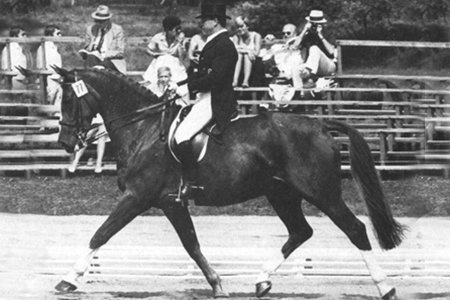
Furioso 15 (by Furioso II) and Udo Lange win the German champions in 1978
The stallion station Vorwerk stood many fine horses, including two more French imports, the Anglo-Arab, Inschallah, and the Selle Français, Zeus, as well as a line-up of wonderful Thoroughbreds, including the Irish bred, More Magic, the sire of dressage gold medal winner at the Moscow Games, Mon Cherie.
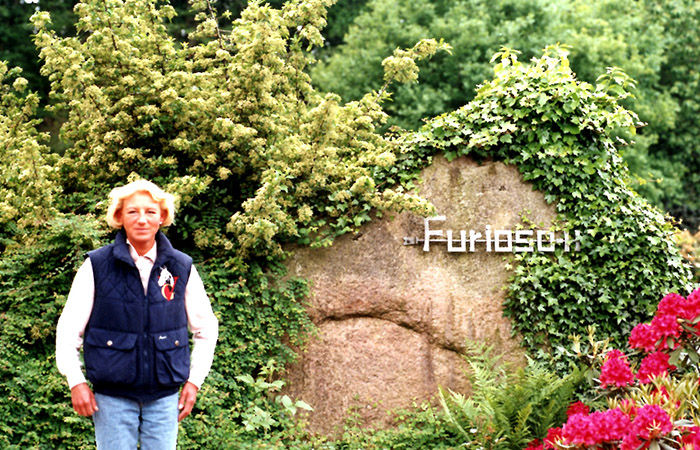
Gudula Vorwerk-Happ standing at a memorial to Furioso II at the Vorwerk Stud
Georg Vorwerk was born in 1923 and died on March 2nd 1988. His daughter, Gudula Vorwerk-Happ took over the stud, her most famous stallion being Rubinstein, who she acquired after the Westfalien licensing commission rejected him, and his son Rohdiamant.
Sadly most of the great private studs of Oldenburg, including Vorwerk (which was sold to the Austrian rider and breeder, Sissy Max-Theurer) have disappeared, as Roland Ramsauer noted sadly in 2017:
“When I started in 1972, we had 32 stallion stations. In every district there were five or six stations, most with just three stallions – only Kathmann, Vorwerk and Schockemöhle had more. Now today we have Paul Schockemöhle, Sprehe, Böckmann, Klatte, Gerd Sosath… It’s a big change.”
Next we enjoy the magic of Grönwoldhof – and marvel at the influence of Donnerhall
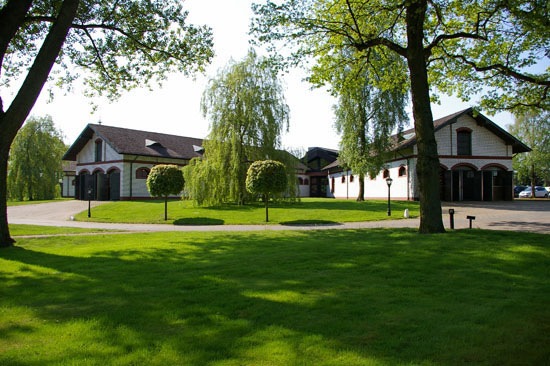
Spend some time with us – the world’s largest archive of equestrian articles awaits – and it’s free…
http://www.horsemagazine.com/thm/
There are lots of representatives of the ‘F’ line are available in Australia for the 2018 season from International Horse Breeders: www.ihb.com.au
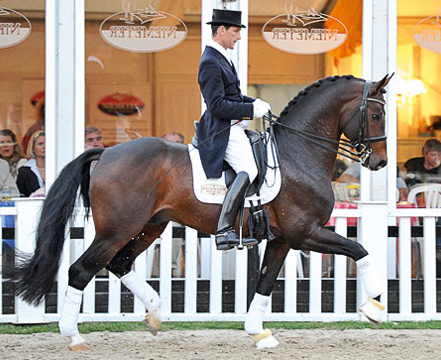 Fidertanz
Fidertanz
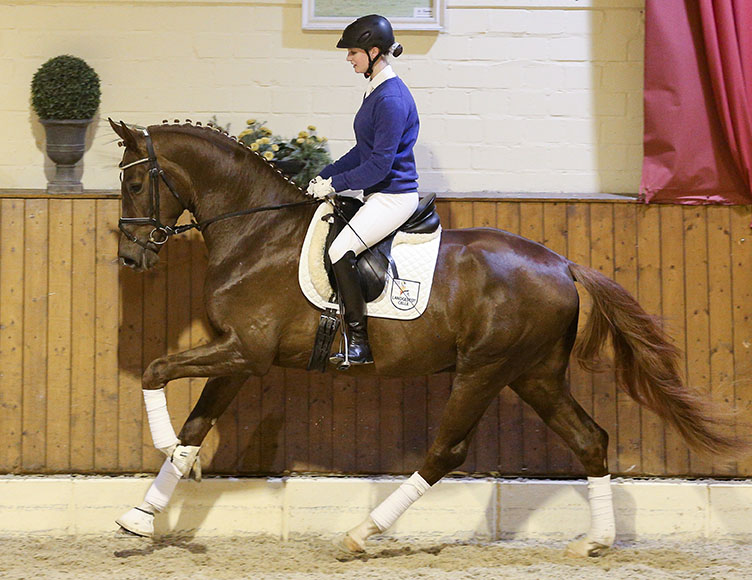
Finnigan
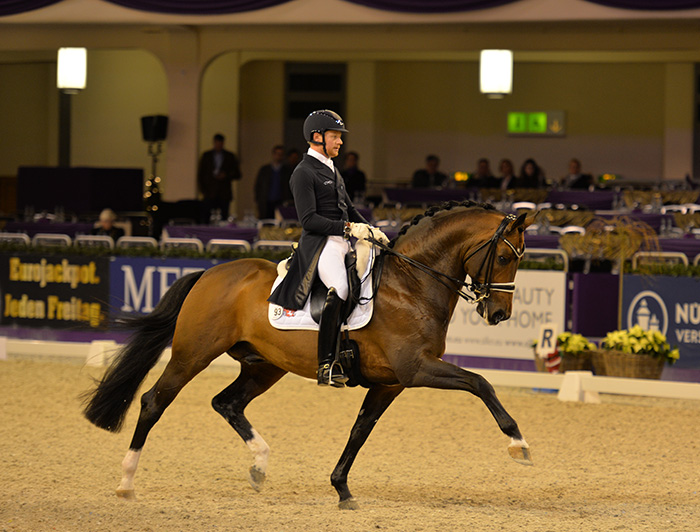
Foundation

Hi Hi
Extrem;ey!! interesting account of German Dressage….PLS continue with it…
A great beginning to a vital study of all the elements involved….much of your article was concerned with blood lines and breading.
Pls pls more!
I promise there is lots lots more, four more parts to be exact, coming soon! regards, Chris Hector
The success of the German sport horses is mainly due to the equilibrium model and this model is a result of the classic and Arabergenen in German warmblood breeding. Hector would do well to pay attention to this functional phenomenon.